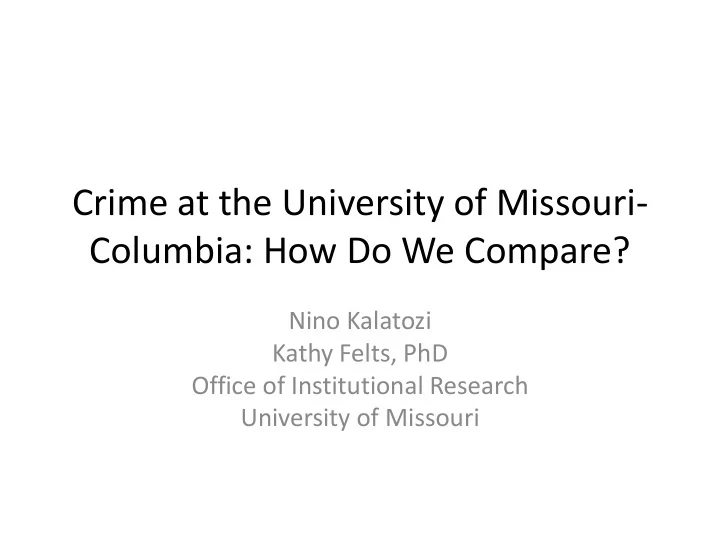

Crime at the University of Missouri ‐ Columbia: How Do We Compare? Nino Kalatozi Kathy Felts, PhD Office of Institutional Research University of Missouri
Problem • Campus violence has become a major issue facing institutions of higher education across the U.S. • Colleges and universities are no longer insulated from the influences of crime and violence which exist in the rest of society.
Purpose To examine the profile of campus crime at the University of Missouri ‐ Columbia and compare MU crime rates to crime rates of Higher Education Institutions in MIDAIR’s states .
Research Questions 1. Has the nature and extent of campus crime at the University of Missouri ‐ Columbia changed over time (2007 and 2009)? 2. How does MU compare to other MIADAIR states higher education institutions in terms of crime rates?
METHODS Data Source • U.S. Department of State Office of Postsecondary Education (OPE) Campus Security Data Analysis Cutting Tool Data. http://ope.ed.gov/security/
Methods (Continued) Data Source • Get data for one institution/campus • Get aggregated data for a group of campuses • Download data for a group of campuses • Download data files
Methods (Continued) Limitations of the dataset: Data collected do not necessarily reflect prosecutions or convictions for • crimes. Data are not directly comparable to data from the FBI's Uniform Crime • Reporting System which only collects statistics from police authorities. The fire statistics are reported only by institutions with an on ‐ campus • student housing facility or facilities, and the fire statistics are for those facilities only. Not all types of crimes are reported. •
Methods (Continued) Sample: ‐ Public 4 ‐ year institutions similar in size to MU from MIDAIR’s six states: Arkansas, Colorado, Iowa, Kansas, Missouri, and Nebraska. Sample Period: ‐ 2007 ‐ 2009.
Methods (Continued) Four categories of crime: • Criminal offenses • Hate crimes • Arrests • Disciplinary actions on campus.
Methods (Continued) Types of Crime: Murder/non ‐ negligent manslaughter • Sex offenses ‐ forcible • Sex offenses – non ‐ forcible • Robbery • Aggravated assault • Burglary • Motor vehicle theft • Arson • Illegal weapons possession • Drug law violations • Liquor law violations •
Methods (Continued) Data Analysis: ‐ Descriptive statistics. ‐ Percentages and 3 ‐ year averages.
Results Criminal Offenses ‐ Burglary (3 ‐ year average 20.2) ‐ Aggravated assault (3 ‐ year average 5.7) ‐ Forcible sex offences (3 ‐ year average 2.7). Hate Crimes ‐ Intimidation (3 ‐ year average 2) ‐ Destruction/damage/ vandalism of property (3 ‐ year average 1.0)
Results (Continued) Arrests ‐ Liquor law violations (3 ‐ year average 116) ‐ Drug abuse violations (3 ‐ year average 99.7). Disciplinary Actions ‐ Liquor law violations (3 ‐ year average 648).
Results (Continued) Changes: ‐ Criminal Offenses: arson ( ‐ 67%). ‐ Disciplinary Actions: liquor law violations (+40%).
Results (Continued) • MU second from the bottom in Criminal Offenses (3 ‐ year average 33). • Tops the list in Hate Crimes (1). • Third highest rates in Arrests (3 ‐ year average 219) and Disciplinary Actions (3 ‐ year average • 648).
IMPLICATIONS The results may push institutional researchers to consider how their • institutions characteristics may be interacting with campus crime rates and encourage them to press their respective institutions to review and improve campus security measures. The results may be important to residence hall coordinators. • Literature suggests that most violent acts are committed in residence halls and other residential facilities that are owned and operated by colleges and universities (Hoffman, Schuh & Fenske, 1998; Palmer 1996). Data should be useful to future indices of campus violence and the • outcome of the data can be useful in searching for reducing incidence of violence.
Recommend
More recommend